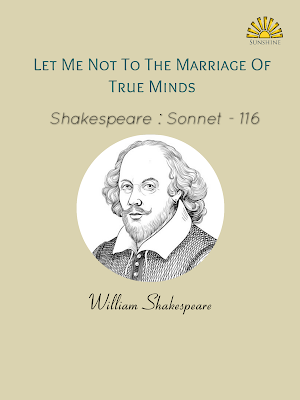 |
| William Shakespeare |
Let Me Not To The Marriage Of True Minds
(Sonnet : 116)
William Shakespeare
Let me not to the marriage of true minds
Admit impediments. Love is not love
Which alters when it alteration finds,
Or bends with the remover to remove.
O no! it is an ever-fixed mark
That looks on tempests and is never shaken;
It is the star to every wand'ring bark,
Whose worth's unknown, although his height be taken.
Love's not Time's fool, though rosy lips and cheeks
Within his bending sickle's compass come;
Love alters not with his brief hours and weeks,
But bears it out even to the edge of doom.
If this be error and upon me prov'd,
I never writ, nor no man ever lov'd.
Summary of "Let Me Not To The Marriage Of True Minds"
This sonnet attempts to define love, by telling both what it is and is not. In the first quatrain, the speaker says that love—”the marriage of true minds”—is perfect and unchanging; it does not “admit impediments,” and it does not change when it find changes in the loved one. In the second quatrain, the speaker tells what love is through a metaphor: a guiding star to lost ships (“wand’ring barks”) that is not susceptible to storms (it “looks on tempests and is never shaken”). In the third quatrain, the speaker again describes what love is not: it is not susceptible to time. Though beauty fades in time as rosy lips and cheeks come within “his bending sickle’s compass,” love does not change with hours and weeks: instead, it “bears it out ev’n to the edge of doom.” In the couplet, the speaker attests to his certainty that love is as he says: if his statements can be proved to be error, he declares, he must never have written a word, and no man can ever have been in love.
Click here for more interesting content.






0 Comments
Have a good day.